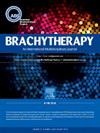3D HDR brachytherapy for cervical cancer in LMIC: Audit of a single institution experience in Lagos, Nigeria
IF 1.7
4区 医学
Q4 ONCOLOGY
引用次数: 0
Abstract
BACKGROUND
The first 3D high-dose-rate brachytherapy (3D-HDR-BT) program for gynecological cancers in Lagos, Nigeria, was launched in August 2021. A retrospective audit of the pilot program was conducted to report the institution's initial experience in treating cervical cancer within the framework of the American Brachytherapy Society (ABS) guidelines.
METHODS AND MATERIALS
24 patients were audited and divided into 2 groups: Group A, which included the first twelve (who had been treated within 3 months of the program launch), and Group B, which included the next twelve (who received treatment over a subsequent period of 5 months).
RESULTS
The average age was 58.04 years, with the most common stage at presentation being FIGO Stage IIB (50%). Squamous cell carcinoma was the prevalent histologic type (87.5% of cases). The predominant EBRT regimen was 1.8Gy x 25 fractions in 66.67% of patients. For brachytherapy, 62.5% received the 8Gy x 3 fractions regimen. All patients received weekly concurrent chemotherapy with external beam radiation, with the majority getting cisplatin monotherapy during external beam radiotherapy (EBRT). The mean dose to D90 of the HR-CTV was 77.48 ± 6.95Gy and 88.93 ± 4.20Gy in Group A and B patients, respectively. A comparative assessment revealed significant improvement in HRCTV D90 doses for Group B patients.
CONCLUSION
We report evident improvement in HRCTV D90 doses with increasing numbers and duration of practice, indicating that team proficiency improves with an increasing number of patients treated. Future studies will focus on overall survival and local control rates among patients treated on the program.
三维HDR近距离治疗LMIC宫颈癌:尼日利亚拉各斯单一机构经验审计。
背景:2021年8月,尼日利亚拉各斯启动了首个针对妇科癌症的3D高剂量率近距离放射治疗(3D- hdr - bt)项目。对试点项目进行了回顾性审核,以报告该机构在美国近距离放射治疗协会(ABS)指南框架内治疗宫颈癌的初步经验。方法与材料:对24例患者进行审计,并将其分为2组:A组为前12例(项目启动后3个月内治疗),B组为后12例(后续5个月治疗)。结果:平均年龄58.04岁,以FIGO分期IIB期最常见(50%)。鳞状细胞癌是常见的组织学类型(87.5%)。66.67%的患者的主要EBRT方案为1.8Gy x 25次。对于近距离治疗,62.5%的患者接受了8Gy x 3分次治疗方案。所有患者每周同时接受外束放疗化疗,大多数患者在外束放疗(EBRT)期间接受顺铂单药治疗。HR-CTV对D90的平均剂量A组为77.48±6.95Gy, B组为88.93±4.20Gy。一项比较评估显示,B组患者的HRCTV D90剂量有显著改善。结论:我们报告了HRCTV D90剂量随着治疗人数和时间的增加而明显改善,表明团队熟练程度随着治疗人数的增加而提高。未来的研究将集中在接受该计划治疗的患者的总生存率和局部控制率上。
本文章由计算机程序翻译,如有差异,请以英文原文为准。
求助全文
约1分钟内获得全文
求助全文
来源期刊

Brachytherapy
医学-核医学
CiteScore
3.40
自引率
21.10%
发文量
119
审稿时长
9.1 weeks
期刊介绍:
Brachytherapy is an international and multidisciplinary journal that publishes original peer-reviewed articles and selected reviews on the techniques and clinical applications of interstitial and intracavitary radiation in the management of cancers. Laboratory and experimental research relevant to clinical practice is also included. Related disciplines include medical physics, medical oncology, and radiation oncology and radiology. Brachytherapy publishes technical advances, original articles, reviews, and point/counterpoint on controversial issues. Original articles that address any aspect of brachytherapy are invited. Letters to the Editor-in-Chief are encouraged.
 求助内容:
求助内容: 应助结果提醒方式:
应助结果提醒方式:


